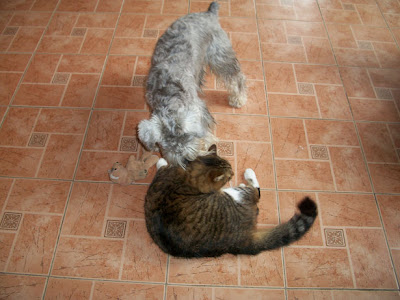One of the very first training exercises you will want to work on with a new puppy or an adult dog moving into your home is house-training!
House-training is indeed a real test of your patience, but it is one of the first opportunities that you and your puppy will have to bond together.
House-training is a lot of hard work, but it is a necessary evil. You will need to have a lot of patience and maybe even a sense of humor as you train your dog. But don't worry, after all of your hard work, you will have a dog that is housetrained!
When it comes down to it, house-training each dog will succeed at it's own rate. It takes some dogs only a few weeks to learn, where it may take other dogs several months.
Here is perhaps the most important thing to know about house-training;
The rate at which a puppy succeeds is determined by the amount of consistent training that you as the caring owner give him. Good quality dog training resources can help you to make this process much easier.
You should begin house-training your puppy as soon as he arrives at your home, which is generally around 7 or 8 weeks old. It is important to understand that he does not have full sphincter muscle control, so puppies are not able to hold their bladder and bowel movements for very long periods of time.
If you are bringing an older dog into your home, that has not yet been house-trained, it may be more of a challenge. Older dogs already have developed their habits, so it will take time and a lot of patience to retrain him. However, it can be done!
All of the lessons below can be applied to both the younger and older dog. It may just take longer with the older dog, so be patient.
Additionally, older dogs eliminate fewer times than puppies throughout the day, so you have fewer opportunities in the day to train him.
Things to Know about House-training;
Before you begin housetraining with your dog, there are some basics that you should know. Including:
Dogs develop natural preferences for where they want to eliminate. For example, dogs usually don't want to eliminate where they eat, sleep, and spend their time.
You may be wondering "So why does my dog eliminate on the rug?" The reason is probably because he was expected to "hold it" too long and wasn't let outside. Or, he may have gotten overly excited about something.
Physical capacity to Hold It;
Young puppies will need to eliminate every one to two hours during the day when they are active. If your pup has been eating, drinking, playing, or exercising a lot, he may need to go even more. They may or may not be able to hold it, throughout the night. Generally, the younger the puppy is, the less he can hold it.
Older dog's that are healthy have the ability to hold it for six to eight hours during the day and eight to ten hours over night.
Then, once you see a pattern, let him out 10-15 minutes before that scheduled time. Of course, he may need to go out more if he has been eating, drinking, playing, or exercising more frequently.
If the situation arises when you need to leave your dog for a longer period than which he can hold it, don't keep him in his crate. Rather, put him in a small room such as a laundry room or bathroom where he can eliminate in an area on newspaper if he needs to, and still keep his sleeping and food area separate.
Sharda Baker
Sharda Baker has published several dog ebook and audios.





